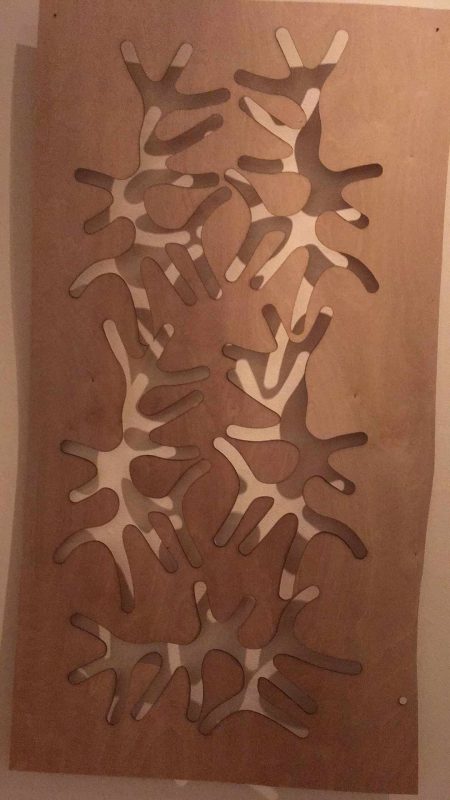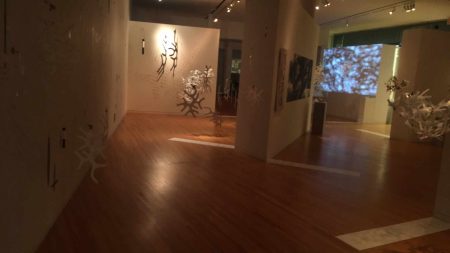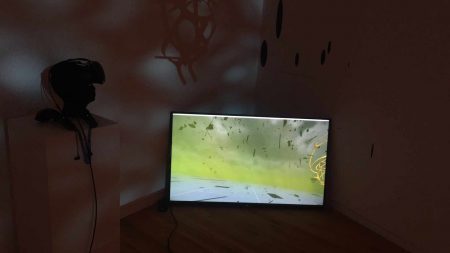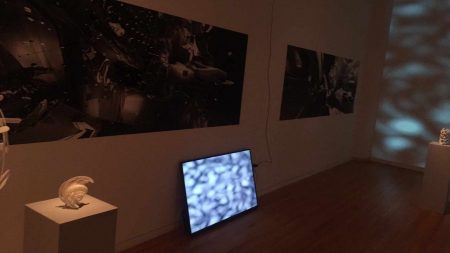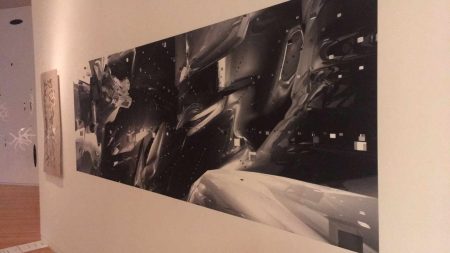Truly a multifaceted artist whose new media processes and technologies wed organic forms with intermedia landscapes, artist Marcos Novak, born in 1957 in Caracas, Venezuela, eruditely explores architecture and industrial design in his installation artwork. During his career as a researcher at Austin University in Texas, Novak began focusing on the relationship between information technology and construction in the early eighties, a practice he has supplemented in Reed Gallery’s “On Ambient Demons: Ringlets of Kronos”, on the campus of The University of Cincinnati.
“On Ambient Demons” features an array of sculptures, installations, and Virtual Reality (VR) headsets. Novak’s mediums all frame ambient spaces: his canvasses display organic forms, including leaves and feathers, which are delicately pinned and tethered to blank services. Novak’s video projections feature “amoeba-like” floating nebulae, formless and indeterminate as they flow and ebb across Reed Gallery’s walls. Novak’s works are untitled, though some of the sculptures – skeletal and biomorphic – are framed by panels that denote biosynthetic processes (e.g. Tryptophan).
A victor of “non-traditional” architecture, Novak’s inspiration is rooted in the study of spatial processes and potential, hence formatting his new media practices, which include maverick digital technologies and algorithmic aural compositions. As Novak describes in an interview with “Floornature: Architecture & Surfaces,” his analytic conformations theorize the existence of “hypersurfaces, hybrids” and combining invisibility with virtuality.
Marcos Novak describes himself as a “trans-architect,” due to his work with computer-generated architectural designs, conceived specifically for the virtual domain, that do not exist in the physical world. His immersive, three-dimensional creations are responsive to the viewer, transformable though user interaction. Hence, the fluid projected forms in Novak’s video art respond to the observer’s movement. As Novak explores interactive new media interspaces, his work has been coined terms with terms such as “transarchitecture” “liquid architecture,” “navigable music,” and “habitable cinema.” These design principles explore non-Euclidean geometry and electronic spaces, which permits the architect to allow his audience to investigate concepts of space that are impossible to explore by any means outside a culmination amongst mathematics, design, and poetry. As one peruses the augmented reality landscapes, they are led into an investigatory landscape with no end destination in site.
Novak has used his theoretical postulates to design liquid sculptures guided by architectural principles, all of which resemble prototypes fitted for a futurist laboratory. Hence, Novak’s work gives the impression of occupying a mediated “hyperreal” world between the physical Real world and a Virtual Real (read: “trans-architectures). Users are invited to investigate the utility of Novak’s sensory virtual realities, an insurmountable task, as it is impossible to physically grasp the fleeting objects before the observational eye.
Marcos Novak is a multi-faceted artist, architect and currently the director of transLAB for media arts and technology. As a researcher at Austin University in Texas, he began to focus on the relationship between information technology and construction in the early eighties. Specializing in industrial design and “non-traditional” architecture, Novak found inspiration in the study of the spatial potential of the new digital technologies, algorithmic compositions and music. On the basis of purely theoretical postulates, Novak has designed numerous prototypes, laboratories and real installations, which remain liquid architectures through mechanical devices, giving the impression of being somewhere between the physical and virtual worlds.
In the new media text “Multimedia: From Wagner to Virtual Reality” Marcos Novak’s section “Liquid Architectures in Cyberspace” (1991) characterizes liquid architecture as an architecture that “breathes, pulses, leaps as one form and lands as another.” Novak terms liquid architecture as a contingent form upon the interests of the beholder. Hence, Novak’s show at the Dorothy W. and C. Lawson Reed, Jr. Gallery utilizes augmented reality, mixed reality, and virtual reality interfaces to explore emerging “social media reality,” transfixing virtual performatory semblances with haptic, aleatory cues. These cues manifest in ambient music that plays during the virtual reality facets of the installation, where one is guided through large, organic-appearing sculptural forms while self-composing drone hums, reminiscent of Brian Eno’s and La Monte Young’s psychologically dense aural experiments.
Randall Packer and Ken Jordan, in “Multimedia: From Wagner to Virtual Reality” describe the “unimaginable complexity” of cyberspace, poetically describing it with Feynman diagrams that trace trajectories from first encounters to physical incarnations. The pair describe moments of “overlap” (276), which defy logical explanation. In this moment of poetic quantum mechanics, world lines overlap, split, divide, blink out of existence and spontaneously reemerge. Such is the case with Novak’s carved, biomorphous sculptures, untitled and overtly blinking of existence while spontaneously reemerging. Curved lines overlap, split, divide, blink out of existence, and spontaneously reemerge. Thus, meanings overlap, as Novak provides panels below his untitled sculptures that read indexes such as amino acids and biosynthesized proteins like “Tryptophan: Essential Acid of Zeus Ammon.”
Novak also mentions how cycles of time entangle, using concentric figures that are carved into one another to underscore how dialectics, past and future, once seemingly independent of one another, can be extricated and intertwined together. Hence, Novak’s aesthetic implorations into quantum mechanical time use themes like fixity, the multiverse, and designated space-time as motifs.
Marcos Novak describes himself as a “trans-architect,” due to his work with computer-generated architectural designs, conceived specifically for the virtual domain, that do not exist in the physical world. His immersive, three-dimensional creations are responsive to the viewer, transformable though user interaction. Exploring the potential of abstract and mathematically conceived forms, Novak has invented a set of conceptual tools for thinking about and constructing territories in cyberspace. Novak creates imaginary landscapes that can only subsist in the digital domain. His metamorphosing 3-D constructions embody musicality, as do his haptic video art pieces, which he has termed “navigable music.” By using virtual reality headsets, Novak explores the hyperreal conditions of habitats of imagination. Verdant and flaxen “landscapes of magic” (Novak 274) occupy Novak’s fixation with cyberspace as a mediation between conscious dreaming and unconscious dreaming, a landscape of mystical reason and “embodied fiction” (275). Navigating the virtual reality semblances and dense sculptures, simulacra of subatomic particles, are difficult to ascribe logically, rendering them as antithetical poetic devices. Novak’s space of art is constructed around cyberspace architecture, where computer-aided design and design computing allow for generative sequences of transforming architectural forms – in Novak’s virtual reality simulations, video art, and audio installations.
Novak’s VR headsets are equipped with headphones for a fully immersive experience allowing observers to trek through Novak’s riveting and infinite digital architecture – floating ominous blocks and sinewy, variegated transforming spheres. Navigating these digital landscapes, one is confronted with the magnanimous virtual sculptures that are reminiscent of Jean Tinguely’s kinetic sculptures (read: Chaos I (1974), rife with machinist musicality) with ambient drone soundscapes to complement. While augmented reality and virtual reality-based intermedia installations often run the gambit of alienating their audience of being circumscribed into “kitsch” art, Novak avoids such shortcomings by providing panorama scenery that is solely to be explored – there exists no utilitarian end goal. Novak’s boundless sculptural works and virtual landscapes are seamlessly explored, requiring no prior knowledge on how to operate such technologies Therefore, Novak’s work can be characterized as purely sensory and experiential.
Novak’s architecture is composed of fluctuating relations between abstract elements – between perusing a field of hyper-real amorphous constructions, filtered with space, form, and light that identify fixtures of the real world. These signifiers of the “real” are sublimated by the liquid architecture of cyberspace – Novak’s dematerialized architecture.
As Jean Baudrillard, a philosopher whose notion of the “hyperreal” frames media simulations within reality (in “Simulacra and Simulation,”), writes “It is the generation by models of a real without origin or reality” that characterize “hyperreal” simulations (170). Novak draws upon these hyperreal conditions, using organic forms framed by biosynthetic constructive principles, to explore simulative landscapes and augmented ethereal experiences.
Novak’s augmented virtual reality landscapes cull Jean Baudrillard’s “hyperreal” conditions of simulation. “Hyperreality” is defined as a condition in where the real and fiction are seamlessly blended, undoing any clear distinction between where on world ends and the other begins. They allow for the co-mingling of physical reality – an architectural substratum upon which Novak constructs his ephemeral world – with ambient virtual reality.
The ever-shifting soft frequencies that provide for atmospheric musical foreground in the gallery space allow for observing audience members to organically feel in tune with Novak’s hyperreal world; observers are distanced from the bounded plains of a physical real world as they inter Novak’s intermedia panoramas. Novak’s sculptures, canvasses, and (especially) his virtual reality landscapes seductively reject gravity, creating an ethereal floating affect. Within the virtual reality simulations, one can reach out and attempt to grasp floating blocks and figures to no avail, characterized by the blending of “reality” and representation. Novak’s work does not engender any clear indication of where one world stops and the latter begins, even outside of his virtual reality installations; this is as product of the luminous, lightly tethered strings and faint particles that comprise Novak’s sculptures.
–Ekin Erkan
Works Cited
Baudrillard, Jean. Simulacra and Simulation. Semiotext(e), Inc., 1983
“Biography of the Architect: Marcos Novak.” Floornature.com, Floor Nature, www.floornature.com/marcos-novak-5052/.
Packer, Randall, and Ken Jordan. Multimedia: From Wagner to Virtual Reality. New York: Norton, 2001. Print.


